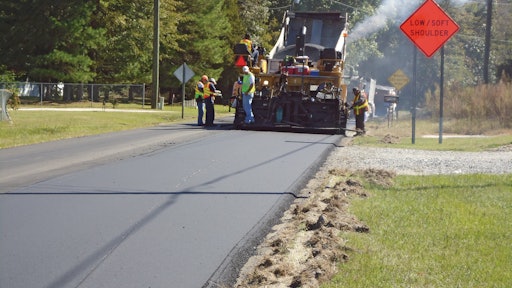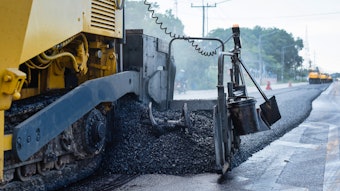
Just over two years ago, James Ross, asphalt/quality control manager with Greenville Paving & Contracting Inc. based in Greenville, NC, was sitting on a plane, returning home from a recycling conference. He had been inspired by the information on recycled asphalt shingles (RAS) and was wondering how he could incorporate RAS into his company’s playbook.
“At the time, AC binder prices were in the $700/ton range,” says Ross. “How do we save money and still put out a quality product? I felt RAS was the answer.”
A long journey
Ross’ journey to include RAS in the mix was filled with a lot of research, roadblocks and some do-overs. But a determined Ross plowed ahead and saw his idea through fruition last summer when two sections of US-258 in North Carolina had a surface course placed with RAS in the mix design.
The first step of the process, Ross explained, was finding the shingles to include in the mix. “Manufacturer-scrapped shingles are basically spoken for in North Carolina,” he says. “To get those, you have to go through a lot of hoops and a lot of lobbying. So, tear-offs were going to have to be the shingle of choice.”
Because tear-offs are used and worn, they tend to have more viable AC in them. Ross felt the higher amount of liquid would help reduce the cost of the mix. And why wouldn’t a landfill want to get rid of its piles of tear-off shingles?
Ross worked with the recycling coordinator in Pitt County, Paula Clark, to obtain shingles. The landfill reworked its permitting structure in order for Greenville Paving to take the shingles out of the landfill.
The next hurdle was the logistics of moving the shingles from the landfill to Greenville’s plant and grinding them.
“Asbestos is a huge concern with RAS,” explains Ross. “I had to educate myself on asbestos and the entire shingle recycling process. I had to come up with a plan, so I flew around the country and visited other plants already doing this; I researched reports; I talked with asbestos inspectors.”
For the first batch of shingles to be ground, Greenville Paving hired an asbestos inspector. The process was expensive, so Ross decided to look into become an accredited asbestos inspector himself. After much paperwork and training, both Ross and his son, Josh Ross, who also works for Greenville Paving as a QC laboratory technician, are certified in asbestos identification using polarized light microscopy in North Carolina. Ross is also an accredited asbestos inspector in South Carolina as well.
Ross was finally at the stage where he could begin experimenting with mix designs involving RAS.
An idea becomes reality
Greenville Paving & Contracting proposed to the North Carolina Department of Transportation (NCDOT) that a resurfacing project such as US-258 would be an excellent job to test a RAS mix.
Greenville Paving had already done two resurfacing pilot projects using this type mix in Martin County, NC in order to gather information on how well this mix was going to work. This allowed Greenville Paving to present data to the NCDOT as proof that the mix would meet all volumetric properties and design criteria required by the specifications.
During the winter of 2010, Ross designed several different types of mixes using the tear-off shingles. Once Ross was satisfied with the designs they were given to QC laboratory technicians John Rose and Josh Ross to put together. The designs were mixed and sent to the NCDOT for approval.
The US-258 project was located in Greene and Lenoir Counties. The project consisted of nine miles of widening, resurfacing and shoulder reconstruction on two sections of US -258.
Mixes used on project included 7,311 tons of B25.0B, (base mix), 23,347 tons of I-19.0B (binder mix), and 13,721 ton of S9.5B (surface mix).Only the S9.5B surface mix had the tear-off shingles in its design.
The base and binder mixes were placed May 11-26 (base) and June 8-16 (binder).
Provisional approval was given on the tear-off shingle and RAP blend S9.5B surface mix design on July 27.
Between August 13-18, approximately 8,000 tons of S9.5B surface mix with recycled tear-off shingles and RAP was placed. The mat was placed at a rate of 168 pounds per square yard at 1 1/2 inches.
Equipment used on the project included a Cat Paver AD1000, two Cat 634D rollers and a Roadtec material transfer vehicle.
Challenges of RAS mixes
Asbestos has already been mentioned as one of the top challenges of using RAS in a mix design. Ross says it may be the number one reason many asphalt contractors hesitate when considering incorporating RAS in their mix designs.
“The cost of getting certified and investing in the lab equipment to test for asbestos was significant, but it will pay for itself in the long run,” says Ross. “Throughout this entire process our owners have been nothing but supportive. They shared my vision and supported every twist and turn we took.”
Another challenge is the cost of grinding. Greenville Paving does its grinding on site with a subcontractor. “The grinding machines are expensive,” says Ross. “We’re at the point where investing in the equipment would be cost prohibitive and wouldn’t help our bottom line. For now, we’re happy having the sub on site doing our grinding.”
Managing the RAS stockpile is yet another challenge. Tear-off shingles sitting in stockpiles can clump together, especially in hot weather.
“We’ve learned to make smaller piles and not drive over the material,” Ross explains. “The most important thing is to keep the moisture out of the pile so the material doesn’t clump together. Ideally, you want the pile under cover. We don’t have a cover, so we regularly fluff up the pile so it doesn’t stick together.”
Benefits
Ross says they’ve seen several improvements — in items such as rutting and volumetric properties — over traditional mixes that don’t include RAS.
Another important improvement: less compactive effort. “Density compaction on a RS9.5B mix is 92% per NCDOT specifications,” says Justin Ross, certified roadway and density technician for Greenville Paving. “While using the mix that contained the tear-off shingles, product densities where running on average 93.2% with less compaction effort than the same mix type without the shingles.”
Another benefit when using tear-offs in the mix: saving money on liquid AC. “Liquid binder is the most expensive component in a mix,” says Ross. “As contractors, we have to be competitive. We have to be the low bidder to get the job, so you have to cut costs but give the same quality mix.”
The future of RAS in North Carolina
Ross is very optimistic about the future of RAS in mix designs. “We’ve had a real positive reaction from the DOT on the US-258 project. A RAS mix is comparable to any other mix, and in some cases it’s even better,” he says. “There are 11 million tons of asphalt shingle waste generated every year. Using RAS will reduce that waste — who wouldn’t think that’s a good idea?”
Todd Whittington, P.E., asphalt design engineer with NCDOT, agrees with Ross and considers the US-258 project a sucess. “We have no complaints,” he says. “This project has met our expectations. If we continue to have sucessful projects like US-258, I believe we’ll proceed cautiously forward and increase the amount of post-consumer shingles we use in other projects.”
Whittington feels strongly that the industry needs to maintain proper controls so the stockpile management process meets North Carolina’s air quality standards.
“This is such a new process,” he explains. “With warm mix asphalt, there’s a lot of support from manufacturers, there’s a lot of trouble-shooting advice ... with RAS you don’t have the support yet or the troubleshooting yet. As this technology gets off the ground, you’ll see more of that, but until then, we have to make sure contractors follow strict guidelines so quality doesn’t suffer.”
Ross understands the caution the NCDOT has taken with RAS. “Understandably, the DOT is worried about the unknown liquid binders coming from the shingles.”
He says that in a few years, there may be some testing that could be done to determine the quality of the liquid binders in the RAS.
Ross also feels the percentage of RAS in a mix will steadily increase as contractors and the NCDOT get used to working with it.
“In the S9.5B surface mix with recycled tear-off shingles that we used on US-258, there was 3% shingles and 12% RAP,” he explains. “I see that increasing.”
In the long run, Ross’ determination to include RAS in Greenville Paving’s mixes paid off. “I was dreaming big on that plane ride home,” he says. “I thought, ‘Why can’t it happen? I can make it happen.’ I believe using RAS in mix designs will only benefit any contractor and state that uses it.”





























